Organisational Behaviour: Culture, Politics, Power & Motivation
VerifiedAdded on 2023/06/13
|17
|5481
|338
Report
AI Summary
This report provides an in-depth analysis of organisational behaviour, focusing on the influence of culture, politics, and power on individual and team performance. It evaluates various content and process theories of motivation and motivational techniques, including Maslow's hierarchy of needs and Adams' equity theory. The report also discusses the characteristics of effective and ineffective teams and examines theories of team development. Furthermore, it applies organisational behaviour concepts and philosophies in the context of Tesco, a multinational retail company, investigating how these concepts influence behaviour both positively and negatively. The analysis covers various aspects of organisational culture, such as cultural levels, the cultural web, and Handy's model of culture, alongside discussions of organisational power, power politics, and leadership styles within Tesco. This document is available on Desklib, a platform offering a wide range of study tools and solved assignments for students.
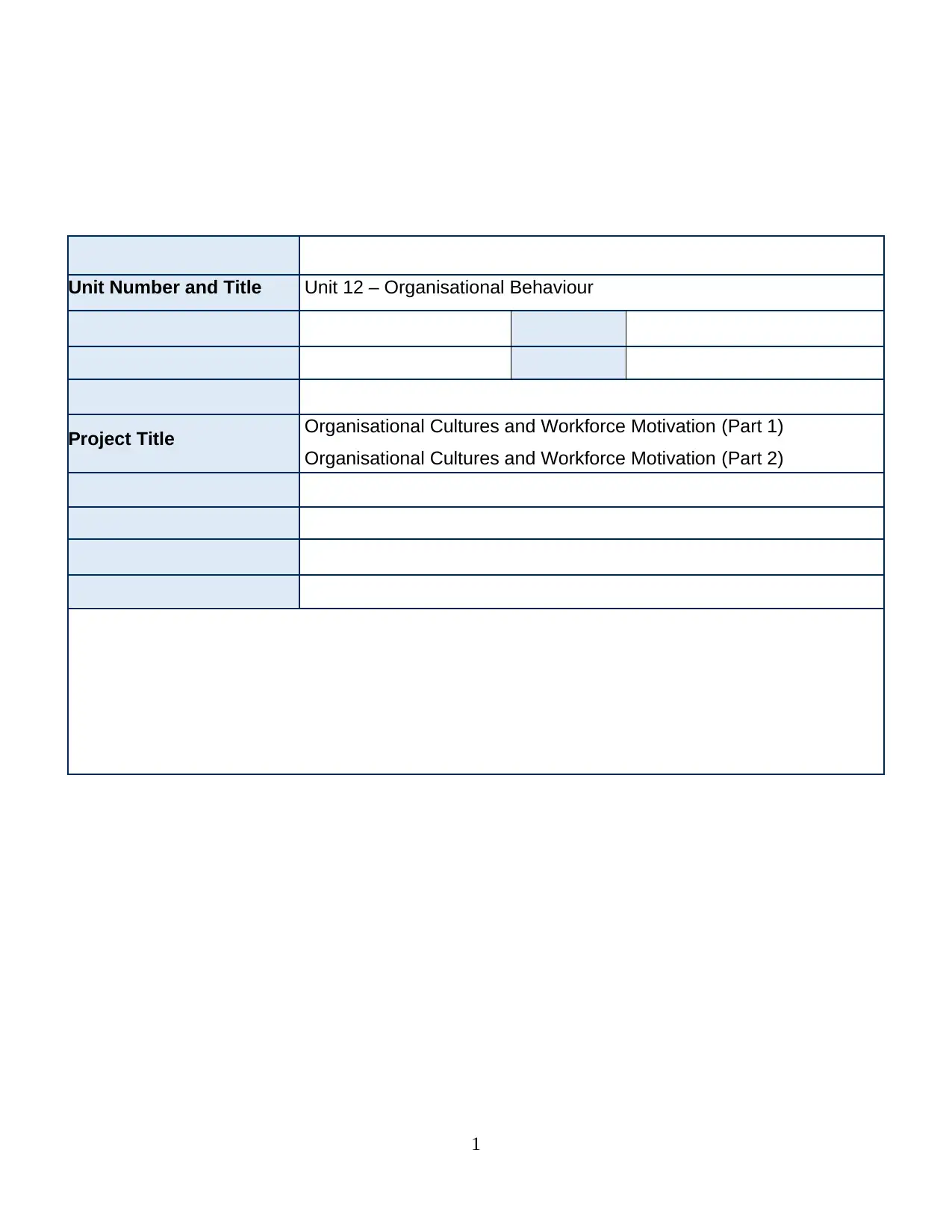
Unit Number and Title Unit 12 – Organisational Behaviour
Project Title Organisational Cultures and Workforce Motivation (Part 1)
Organisational Cultures and Workforce Motivation (Part 2)
1
Project Title Organisational Cultures and Workforce Motivation (Part 1)
Organisational Cultures and Workforce Motivation (Part 2)
1
Paraphrase This Document
Need a fresh take? Get an instant paraphrase of this document with our AI Paraphraser
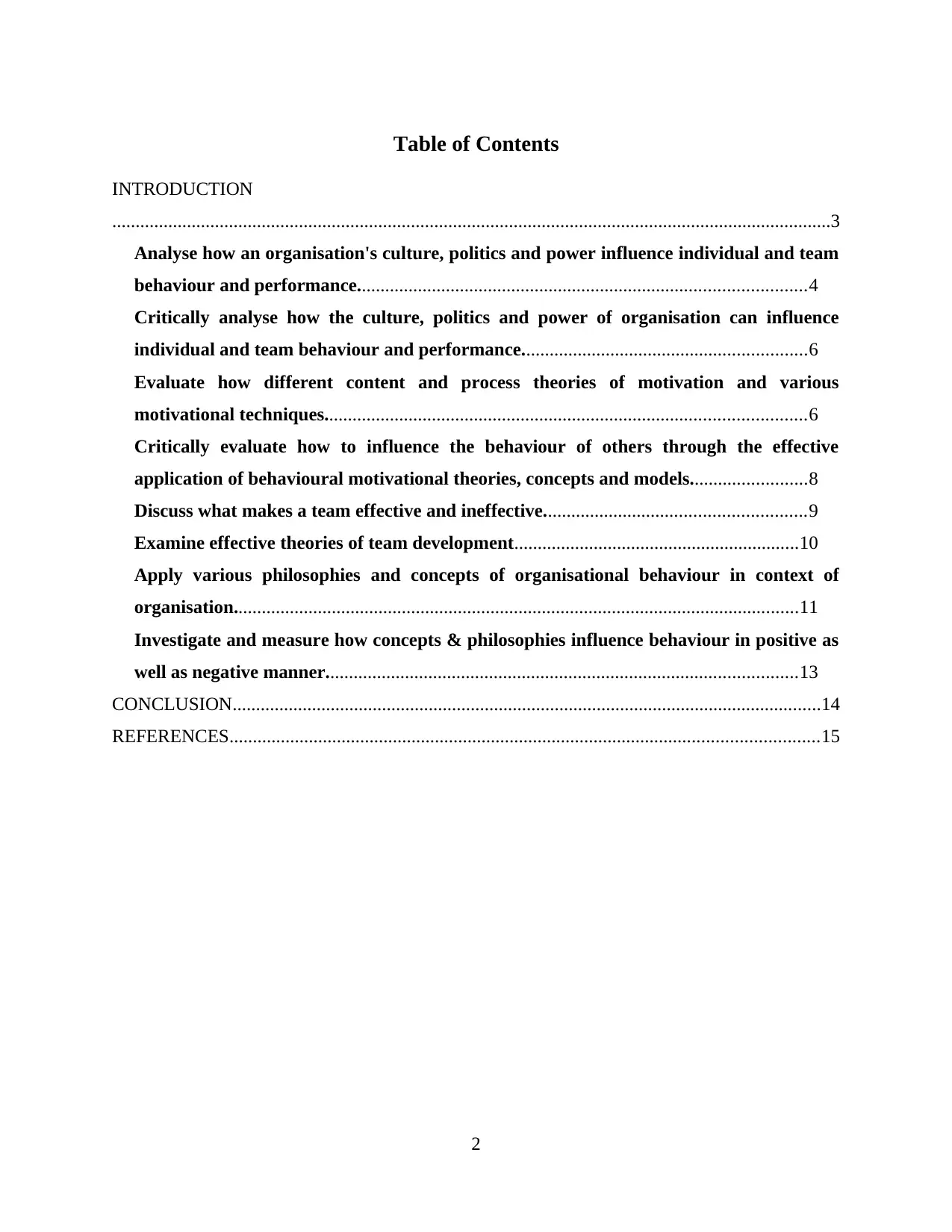
Table of Contents
INTRODUCTION
..........................................................................................................................................................3
Analyse how an organisation's culture, politics and power influence individual and team
behaviour and performance................................................................................................4
Critically analyse how the culture, politics and power of organisation can influence
individual and team behaviour and performance.............................................................6
Evaluate how different content and process theories of motivation and various
motivational techniques.......................................................................................................6
Critically evaluate how to influence the behaviour of others through the effective
application of behavioural motivational theories, concepts and models.........................8
Discuss what makes a team effective and ineffective........................................................9
Examine effective theories of team development.............................................................10
Apply various philosophies and concepts of organisational behaviour in context of
organisation.........................................................................................................................11
Investigate and measure how concepts & philosophies influence behaviour in positive as
well as negative manner.....................................................................................................13
CONCLUSION..............................................................................................................................14
REFERENCES..............................................................................................................................15
2
INTRODUCTION
..........................................................................................................................................................3
Analyse how an organisation's culture, politics and power influence individual and team
behaviour and performance................................................................................................4
Critically analyse how the culture, politics and power of organisation can influence
individual and team behaviour and performance.............................................................6
Evaluate how different content and process theories of motivation and various
motivational techniques.......................................................................................................6
Critically evaluate how to influence the behaviour of others through the effective
application of behavioural motivational theories, concepts and models.........................8
Discuss what makes a team effective and ineffective........................................................9
Examine effective theories of team development.............................................................10
Apply various philosophies and concepts of organisational behaviour in context of
organisation.........................................................................................................................11
Investigate and measure how concepts & philosophies influence behaviour in positive as
well as negative manner.....................................................................................................13
CONCLUSION..............................................................................................................................14
REFERENCES..............................................................................................................................15
2
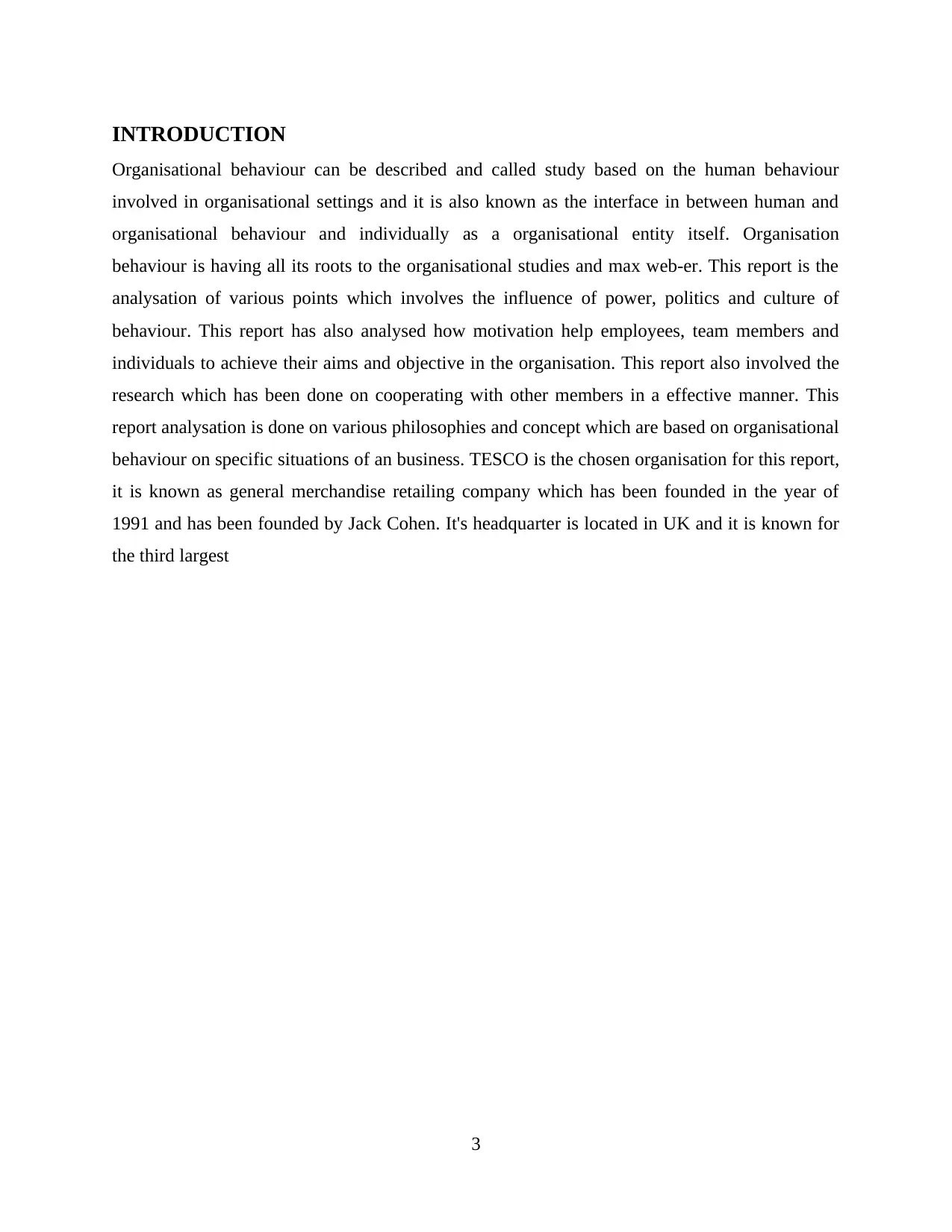
INTRODUCTION
Organisational behaviour can be described and called study based on the human behaviour
involved in organisational settings and it is also known as the interface in between human and
organisational behaviour and individually as a organisational entity itself. Organisation
behaviour is having all its roots to the organisational studies and max web-er. This report is the
analysation of various points which involves the influence of power, politics and culture of
behaviour. This report has also analysed how motivation help employees, team members and
individuals to achieve their aims and objective in the organisation. This report also involved the
research which has been done on cooperating with other members in a effective manner. This
report analysation is done on various philosophies and concept which are based on organisational
behaviour on specific situations of an business. TESCO is the chosen organisation for this report,
it is known as general merchandise retailing company which has been founded in the year of
1991 and has been founded by Jack Cohen. It's headquarter is located in UK and it is known for
the third largest
3
Organisational behaviour can be described and called study based on the human behaviour
involved in organisational settings and it is also known as the interface in between human and
organisational behaviour and individually as a organisational entity itself. Organisation
behaviour is having all its roots to the organisational studies and max web-er. This report is the
analysation of various points which involves the influence of power, politics and culture of
behaviour. This report has also analysed how motivation help employees, team members and
individuals to achieve their aims and objective in the organisation. This report also involved the
research which has been done on cooperating with other members in a effective manner. This
report analysation is done on various philosophies and concept which are based on organisational
behaviour on specific situations of an business. TESCO is the chosen organisation for this report,
it is known as general merchandise retailing company which has been founded in the year of
1991 and has been founded by Jack Cohen. It's headquarter is located in UK and it is known for
the third largest
3
⊘ This is a preview!⊘
Do you want full access?
Subscribe today to unlock all pages.

Trusted by 1+ million students worldwide
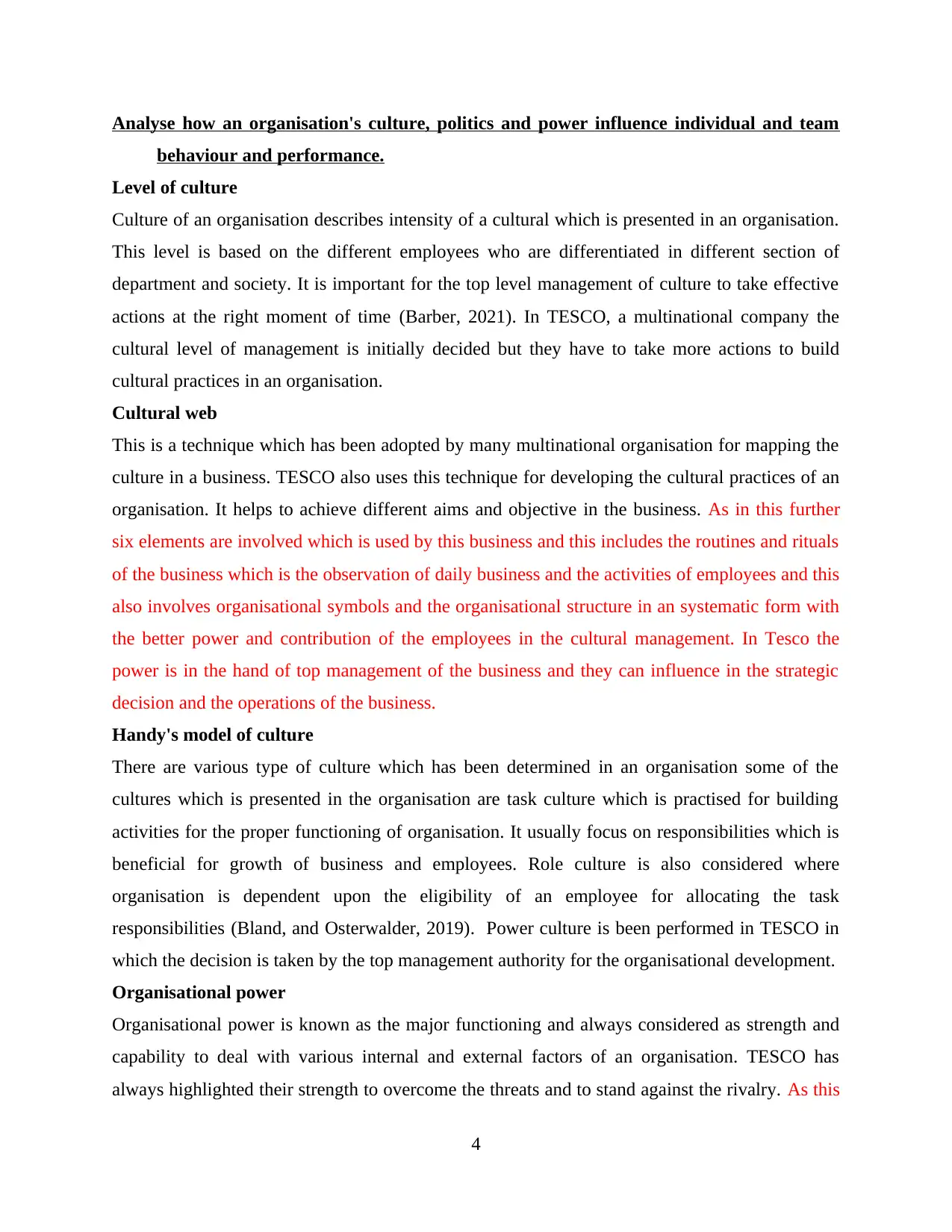
Analyse how an organisation's culture, politics and power influence individual and team
behaviour and performance.
Level of culture
Culture of an organisation describes intensity of a cultural which is presented in an organisation.
This level is based on the different employees who are differentiated in different section of
department and society. It is important for the top level management of culture to take effective
actions at the right moment of time (Barber, 2021). In TESCO, a multinational company the
cultural level of management is initially decided but they have to take more actions to build
cultural practices in an organisation.
Cultural web
This is a technique which has been adopted by many multinational organisation for mapping the
culture in a business. TESCO also uses this technique for developing the cultural practices of an
organisation. It helps to achieve different aims and objective in the business. As in this further
six elements are involved which is used by this business and this includes the routines and rituals
of the business which is the observation of daily business and the activities of employees and this
also involves organisational symbols and the organisational structure in an systematic form with
the better power and contribution of the employees in the cultural management. In Tesco the
power is in the hand of top management of the business and they can influence in the strategic
decision and the operations of the business.
Handy's model of culture
There are various type of culture which has been determined in an organisation some of the
cultures which is presented in the organisation are task culture which is practised for building
activities for the proper functioning of organisation. It usually focus on responsibilities which is
beneficial for growth of business and employees. Role culture is also considered where
organisation is dependent upon the eligibility of an employee for allocating the task
responsibilities (Bland, and Osterwalder, 2019). Power culture is been performed in TESCO in
which the decision is taken by the top management authority for the organisational development.
Organisational power
Organisational power is known as the major functioning and always considered as strength and
capability to deal with various internal and external factors of an organisation. TESCO has
always highlighted their strength to overcome the threats and to stand against the rivalry. As this
4
behaviour and performance.
Level of culture
Culture of an organisation describes intensity of a cultural which is presented in an organisation.
This level is based on the different employees who are differentiated in different section of
department and society. It is important for the top level management of culture to take effective
actions at the right moment of time (Barber, 2021). In TESCO, a multinational company the
cultural level of management is initially decided but they have to take more actions to build
cultural practices in an organisation.
Cultural web
This is a technique which has been adopted by many multinational organisation for mapping the
culture in a business. TESCO also uses this technique for developing the cultural practices of an
organisation. It helps to achieve different aims and objective in the business. As in this further
six elements are involved which is used by this business and this includes the routines and rituals
of the business which is the observation of daily business and the activities of employees and this
also involves organisational symbols and the organisational structure in an systematic form with
the better power and contribution of the employees in the cultural management. In Tesco the
power is in the hand of top management of the business and they can influence in the strategic
decision and the operations of the business.
Handy's model of culture
There are various type of culture which has been determined in an organisation some of the
cultures which is presented in the organisation are task culture which is practised for building
activities for the proper functioning of organisation. It usually focus on responsibilities which is
beneficial for growth of business and employees. Role culture is also considered where
organisation is dependent upon the eligibility of an employee for allocating the task
responsibilities (Bland, and Osterwalder, 2019). Power culture is been performed in TESCO in
which the decision is taken by the top management authority for the organisational development.
Organisational power
Organisational power is known as the major functioning and always considered as strength and
capability to deal with various internal and external factors of an organisation. TESCO has
always highlighted their strength to overcome the threats and to stand against the rivalry. As this
4
Paraphrase This Document
Need a fresh take? Get an instant paraphrase of this document with our AI Paraphraser
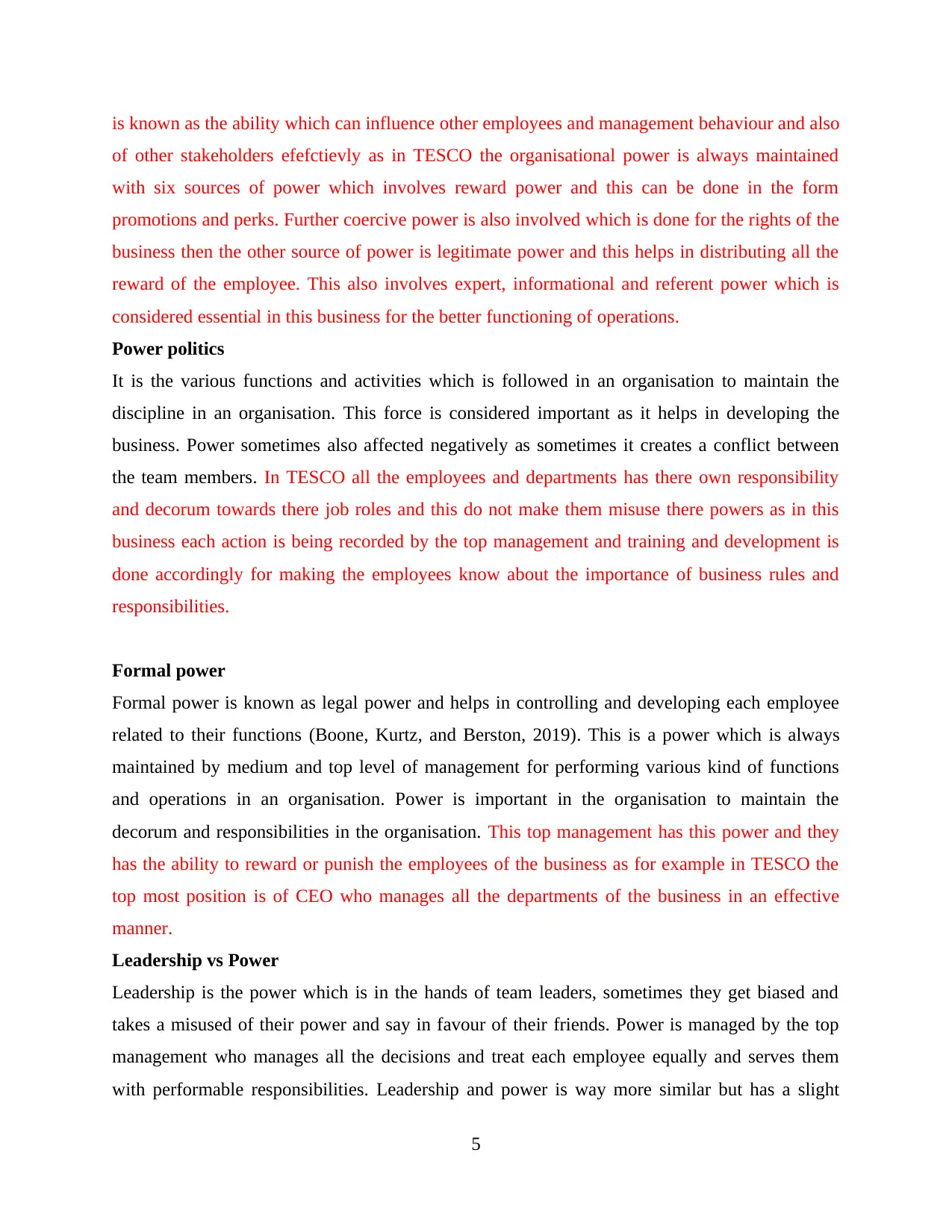
is known as the ability which can influence other employees and management behaviour and also
of other stakeholders efefctievly as in TESCO the organisational power is always maintained
with six sources of power which involves reward power and this can be done in the form
promotions and perks. Further coercive power is also involved which is done for the rights of the
business then the other source of power is legitimate power and this helps in distributing all the
reward of the employee. This also involves expert, informational and referent power which is
considered essential in this business for the better functioning of operations.
Power politics
It is the various functions and activities which is followed in an organisation to maintain the
discipline in an organisation. This force is considered important as it helps in developing the
business. Power sometimes also affected negatively as sometimes it creates a conflict between
the team members. In TESCO all the employees and departments has there own responsibility
and decorum towards there job roles and this do not make them misuse there powers as in this
business each action is being recorded by the top management and training and development is
done accordingly for making the employees know about the importance of business rules and
responsibilities.
Formal power
Formal power is known as legal power and helps in controlling and developing each employee
related to their functions (Boone, Kurtz, and Berston, 2019). This is a power which is always
maintained by medium and top level of management for performing various kind of functions
and operations in an organisation. Power is important in the organisation to maintain the
decorum and responsibilities in the organisation. This top management has this power and they
has the ability to reward or punish the employees of the business as for example in TESCO the
top most position is of CEO who manages all the departments of the business in an effective
manner.
Leadership vs Power
Leadership is the power which is in the hands of team leaders, sometimes they get biased and
takes a misused of their power and say in favour of their friends. Power is managed by the top
management who manages all the decisions and treat each employee equally and serves them
with performable responsibilities. Leadership and power is way more similar but has a slight
5
of other stakeholders efefctievly as in TESCO the organisational power is always maintained
with six sources of power which involves reward power and this can be done in the form
promotions and perks. Further coercive power is also involved which is done for the rights of the
business then the other source of power is legitimate power and this helps in distributing all the
reward of the employee. This also involves expert, informational and referent power which is
considered essential in this business for the better functioning of operations.
Power politics
It is the various functions and activities which is followed in an organisation to maintain the
discipline in an organisation. This force is considered important as it helps in developing the
business. Power sometimes also affected negatively as sometimes it creates a conflict between
the team members. In TESCO all the employees and departments has there own responsibility
and decorum towards there job roles and this do not make them misuse there powers as in this
business each action is being recorded by the top management and training and development is
done accordingly for making the employees know about the importance of business rules and
responsibilities.
Formal power
Formal power is known as legal power and helps in controlling and developing each employee
related to their functions (Boone, Kurtz, and Berston, 2019). This is a power which is always
maintained by medium and top level of management for performing various kind of functions
and operations in an organisation. Power is important in the organisation to maintain the
decorum and responsibilities in the organisation. This top management has this power and they
has the ability to reward or punish the employees of the business as for example in TESCO the
top most position is of CEO who manages all the departments of the business in an effective
manner.
Leadership vs Power
Leadership is the power which is in the hands of team leaders, sometimes they get biased and
takes a misused of their power and say in favour of their friends. Power is managed by the top
management who manages all the decisions and treat each employee equally and serves them
with performable responsibilities. Leadership and power is way more similar but has a slight
5
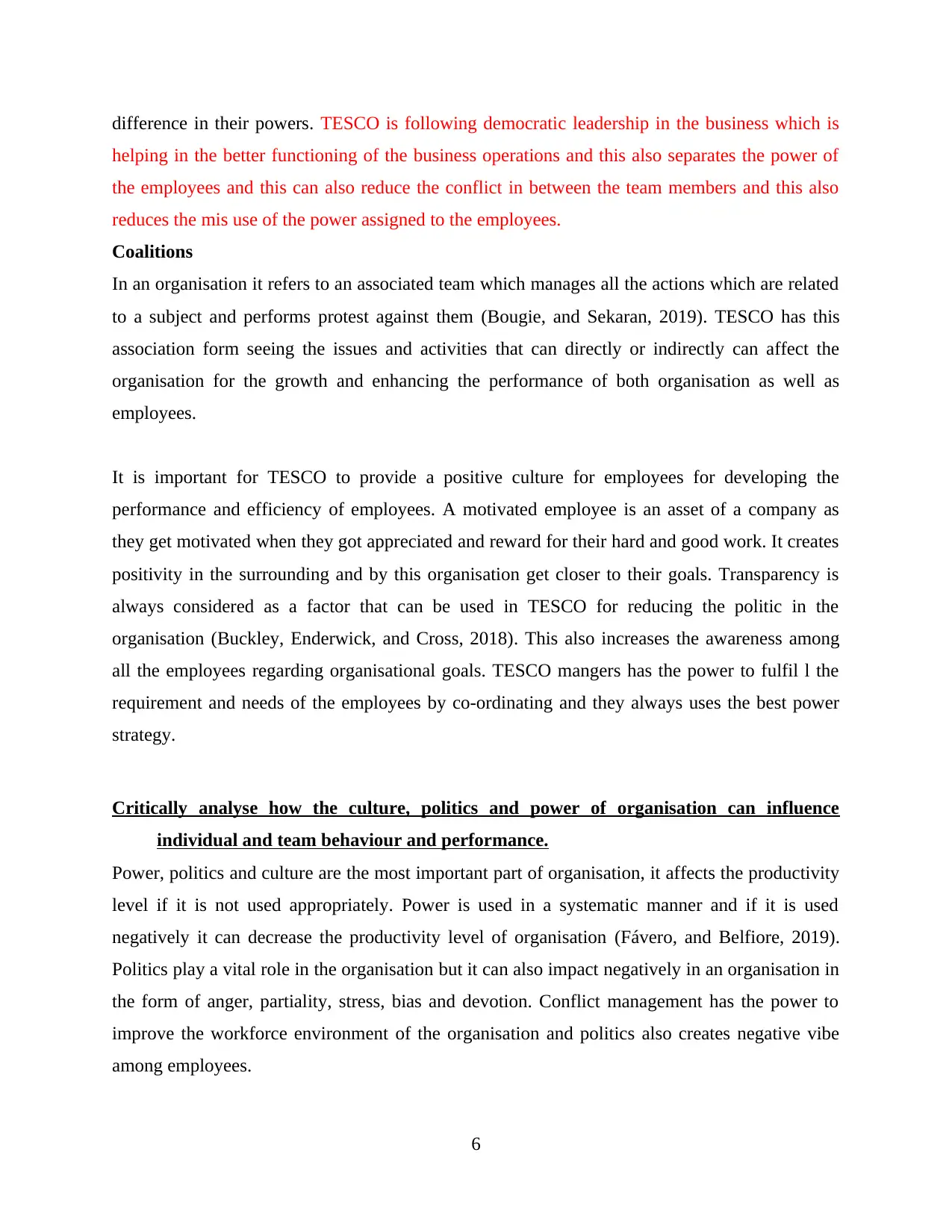
difference in their powers. TESCO is following democratic leadership in the business which is
helping in the better functioning of the business operations and this also separates the power of
the employees and this can also reduce the conflict in between the team members and this also
reduces the mis use of the power assigned to the employees.
Coalitions
In an organisation it refers to an associated team which manages all the actions which are related
to a subject and performs protest against them (Bougie, and Sekaran, 2019). TESCO has this
association form seeing the issues and activities that can directly or indirectly can affect the
organisation for the growth and enhancing the performance of both organisation as well as
employees.
It is important for TESCO to provide a positive culture for employees for developing the
performance and efficiency of employees. A motivated employee is an asset of a company as
they get motivated when they got appreciated and reward for their hard and good work. It creates
positivity in the surrounding and by this organisation get closer to their goals. Transparency is
always considered as a factor that can be used in TESCO for reducing the politic in the
organisation (Buckley, Enderwick, and Cross, 2018). This also increases the awareness among
all the employees regarding organisational goals. TESCO mangers has the power to fulfil l the
requirement and needs of the employees by co-ordinating and they always uses the best power
strategy.
Critically analyse how the culture, politics and power of organisation can influence
individual and team behaviour and performance.
Power, politics and culture are the most important part of organisation, it affects the productivity
level if it is not used appropriately. Power is used in a systematic manner and if it is used
negatively it can decrease the productivity level of organisation (Fávero, and Belfiore, 2019).
Politics play a vital role in the organisation but it can also impact negatively in an organisation in
the form of anger, partiality, stress, bias and devotion. Conflict management has the power to
improve the workforce environment of the organisation and politics also creates negative vibe
among employees.
6
helping in the better functioning of the business operations and this also separates the power of
the employees and this can also reduce the conflict in between the team members and this also
reduces the mis use of the power assigned to the employees.
Coalitions
In an organisation it refers to an associated team which manages all the actions which are related
to a subject and performs protest against them (Bougie, and Sekaran, 2019). TESCO has this
association form seeing the issues and activities that can directly or indirectly can affect the
organisation for the growth and enhancing the performance of both organisation as well as
employees.
It is important for TESCO to provide a positive culture for employees for developing the
performance and efficiency of employees. A motivated employee is an asset of a company as
they get motivated when they got appreciated and reward for their hard and good work. It creates
positivity in the surrounding and by this organisation get closer to their goals. Transparency is
always considered as a factor that can be used in TESCO for reducing the politic in the
organisation (Buckley, Enderwick, and Cross, 2018). This also increases the awareness among
all the employees regarding organisational goals. TESCO mangers has the power to fulfil l the
requirement and needs of the employees by co-ordinating and they always uses the best power
strategy.
Critically analyse how the culture, politics and power of organisation can influence
individual and team behaviour and performance.
Power, politics and culture are the most important part of organisation, it affects the productivity
level if it is not used appropriately. Power is used in a systematic manner and if it is used
negatively it can decrease the productivity level of organisation (Fávero, and Belfiore, 2019).
Politics play a vital role in the organisation but it can also impact negatively in an organisation in
the form of anger, partiality, stress, bias and devotion. Conflict management has the power to
improve the workforce environment of the organisation and politics also creates negative vibe
among employees.
6
⊘ This is a preview!⊘
Do you want full access?
Subscribe today to unlock all pages.

Trusted by 1+ million students worldwide
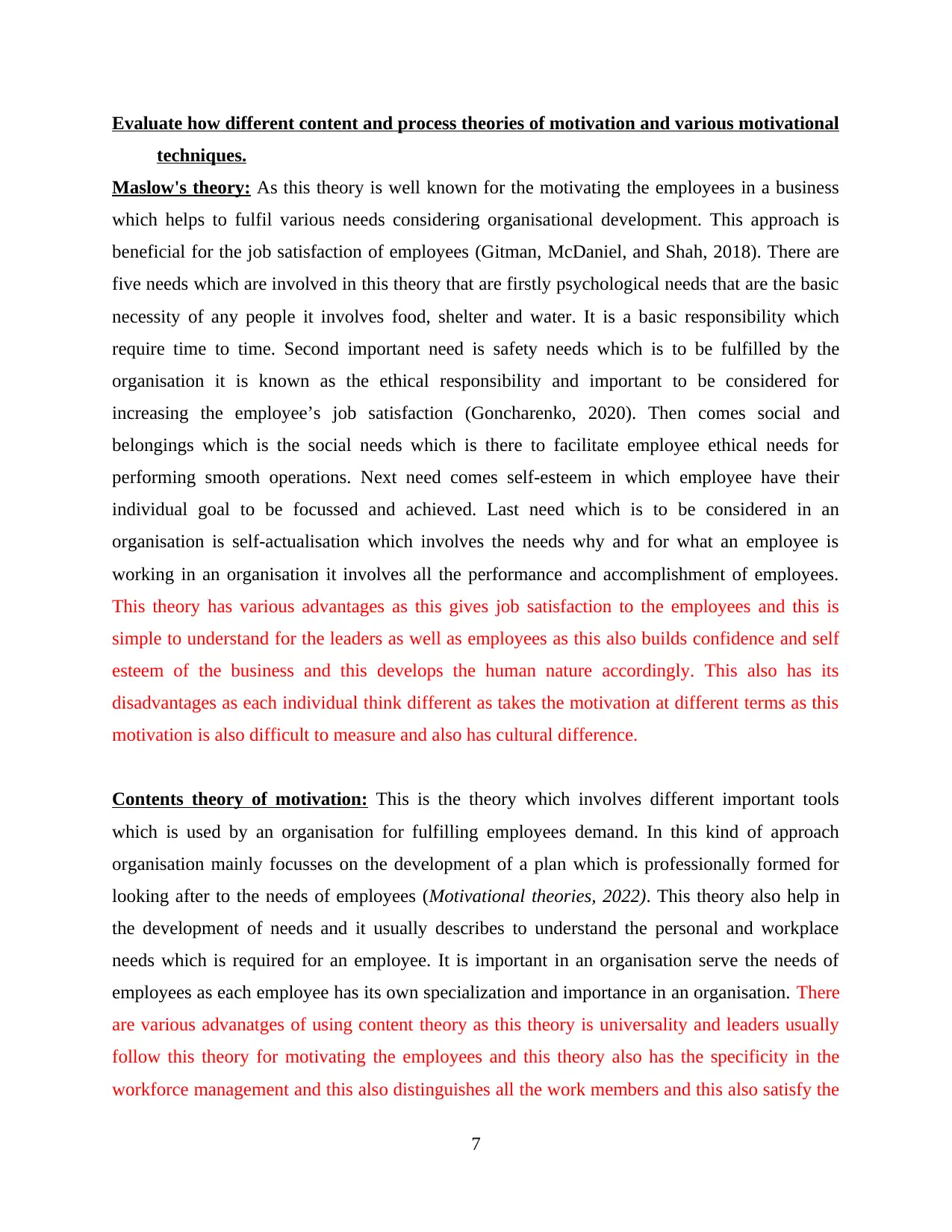
Evaluate how different content and process theories of motivation and various motivational
techniques.
Maslow's theory: As this theory is well known for the motivating the employees in a business
which helps to fulfil various needs considering organisational development. This approach is
beneficial for the job satisfaction of employees (Gitman, McDaniel, and Shah, 2018). There are
five needs which are involved in this theory that are firstly psychological needs that are the basic
necessity of any people it involves food, shelter and water. It is a basic responsibility which
require time to time. Second important need is safety needs which is to be fulfilled by the
organisation it is known as the ethical responsibility and important to be considered for
increasing the employee’s job satisfaction (Goncharenko, 2020). Then comes social and
belongings which is the social needs which is there to facilitate employee ethical needs for
performing smooth operations. Next need comes self-esteem in which employee have their
individual goal to be focussed and achieved. Last need which is to be considered in an
organisation is self-actualisation which involves the needs why and for what an employee is
working in an organisation it involves all the performance and accomplishment of employees.
This theory has various advantages as this gives job satisfaction to the employees and this is
simple to understand for the leaders as well as employees as this also builds confidence and self
esteem of the business and this develops the human nature accordingly. This also has its
disadvantages as each individual think different as takes the motivation at different terms as this
motivation is also difficult to measure and also has cultural difference.
Contents theory of motivation: This is the theory which involves different important tools
which is used by an organisation for fulfilling employees demand. In this kind of approach
organisation mainly focusses on the development of a plan which is professionally formed for
looking after to the needs of employees (Motivational theories, 2022). This theory also help in
the development of needs and it usually describes to understand the personal and workplace
needs which is required for an employee. It is important in an organisation serve the needs of
employees as each employee has its own specialization and importance in an organisation. There
are various advanatges of using content theory as this theory is universality and leaders usually
follow this theory for motivating the employees and this theory also has the specificity in the
workforce management and this also distinguishes all the work members and this also satisfy the
7
techniques.
Maslow's theory: As this theory is well known for the motivating the employees in a business
which helps to fulfil various needs considering organisational development. This approach is
beneficial for the job satisfaction of employees (Gitman, McDaniel, and Shah, 2018). There are
five needs which are involved in this theory that are firstly psychological needs that are the basic
necessity of any people it involves food, shelter and water. It is a basic responsibility which
require time to time. Second important need is safety needs which is to be fulfilled by the
organisation it is known as the ethical responsibility and important to be considered for
increasing the employee’s job satisfaction (Goncharenko, 2020). Then comes social and
belongings which is the social needs which is there to facilitate employee ethical needs for
performing smooth operations. Next need comes self-esteem in which employee have their
individual goal to be focussed and achieved. Last need which is to be considered in an
organisation is self-actualisation which involves the needs why and for what an employee is
working in an organisation it involves all the performance and accomplishment of employees.
This theory has various advantages as this gives job satisfaction to the employees and this is
simple to understand for the leaders as well as employees as this also builds confidence and self
esteem of the business and this develops the human nature accordingly. This also has its
disadvantages as each individual think different as takes the motivation at different terms as this
motivation is also difficult to measure and also has cultural difference.
Contents theory of motivation: This is the theory which involves different important tools
which is used by an organisation for fulfilling employees demand. In this kind of approach
organisation mainly focusses on the development of a plan which is professionally formed for
looking after to the needs of employees (Motivational theories, 2022). This theory also help in
the development of needs and it usually describes to understand the personal and workplace
needs which is required for an employee. It is important in an organisation serve the needs of
employees as each employee has its own specialization and importance in an organisation. There
are various advanatges of using content theory as this theory is universality and leaders usually
follow this theory for motivating the employees and this theory also has the specificity in the
workforce management and this also distinguishes all the work members and this also satisfy the
7
Paraphrase This Document
Need a fresh take? Get an instant paraphrase of this document with our AI Paraphraser
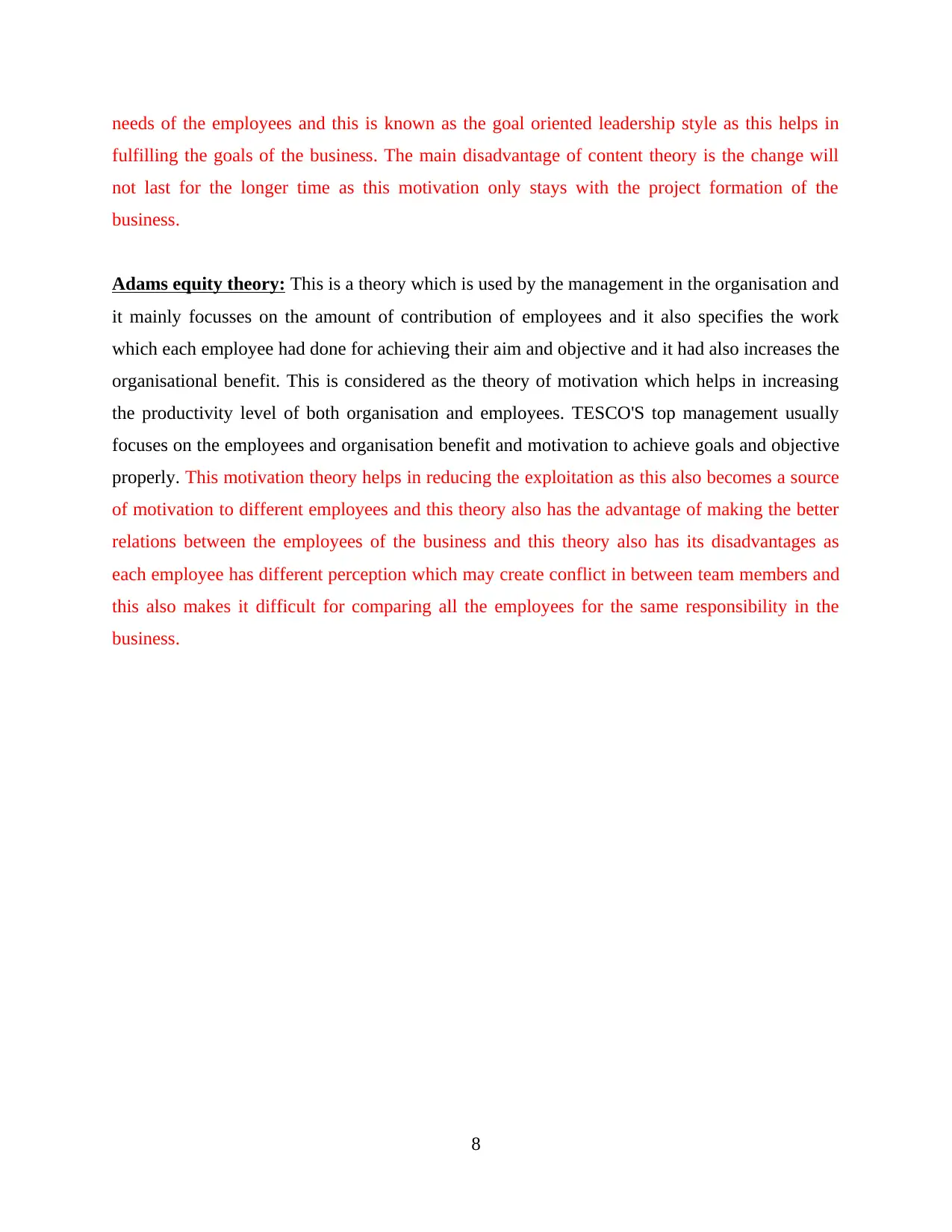
needs of the employees and this is known as the goal oriented leadership style as this helps in
fulfilling the goals of the business. The main disadvantage of content theory is the change will
not last for the longer time as this motivation only stays with the project formation of the
business.
Adams equity theory: This is a theory which is used by the management in the organisation and
it mainly focusses on the amount of contribution of employees and it also specifies the work
which each employee had done for achieving their aim and objective and it had also increases the
organisational benefit. This is considered as the theory of motivation which helps in increasing
the productivity level of both organisation and employees. TESCO'S top management usually
focuses on the employees and organisation benefit and motivation to achieve goals and objective
properly. This motivation theory helps in reducing the exploitation as this also becomes a source
of motivation to different employees and this theory also has the advantage of making the better
relations between the employees of the business and this theory also has its disadvantages as
each employee has different perception which may create conflict in between team members and
this also makes it difficult for comparing all the employees for the same responsibility in the
business.
8
fulfilling the goals of the business. The main disadvantage of content theory is the change will
not last for the longer time as this motivation only stays with the project formation of the
business.
Adams equity theory: This is a theory which is used by the management in the organisation and
it mainly focusses on the amount of contribution of employees and it also specifies the work
which each employee had done for achieving their aim and objective and it had also increases the
organisational benefit. This is considered as the theory of motivation which helps in increasing
the productivity level of both organisation and employees. TESCO'S top management usually
focuses on the employees and organisation benefit and motivation to achieve goals and objective
properly. This motivation theory helps in reducing the exploitation as this also becomes a source
of motivation to different employees and this theory also has the advantage of making the better
relations between the employees of the business and this theory also has its disadvantages as
each employee has different perception which may create conflict in between team members and
this also makes it difficult for comparing all the employees for the same responsibility in the
business.
8
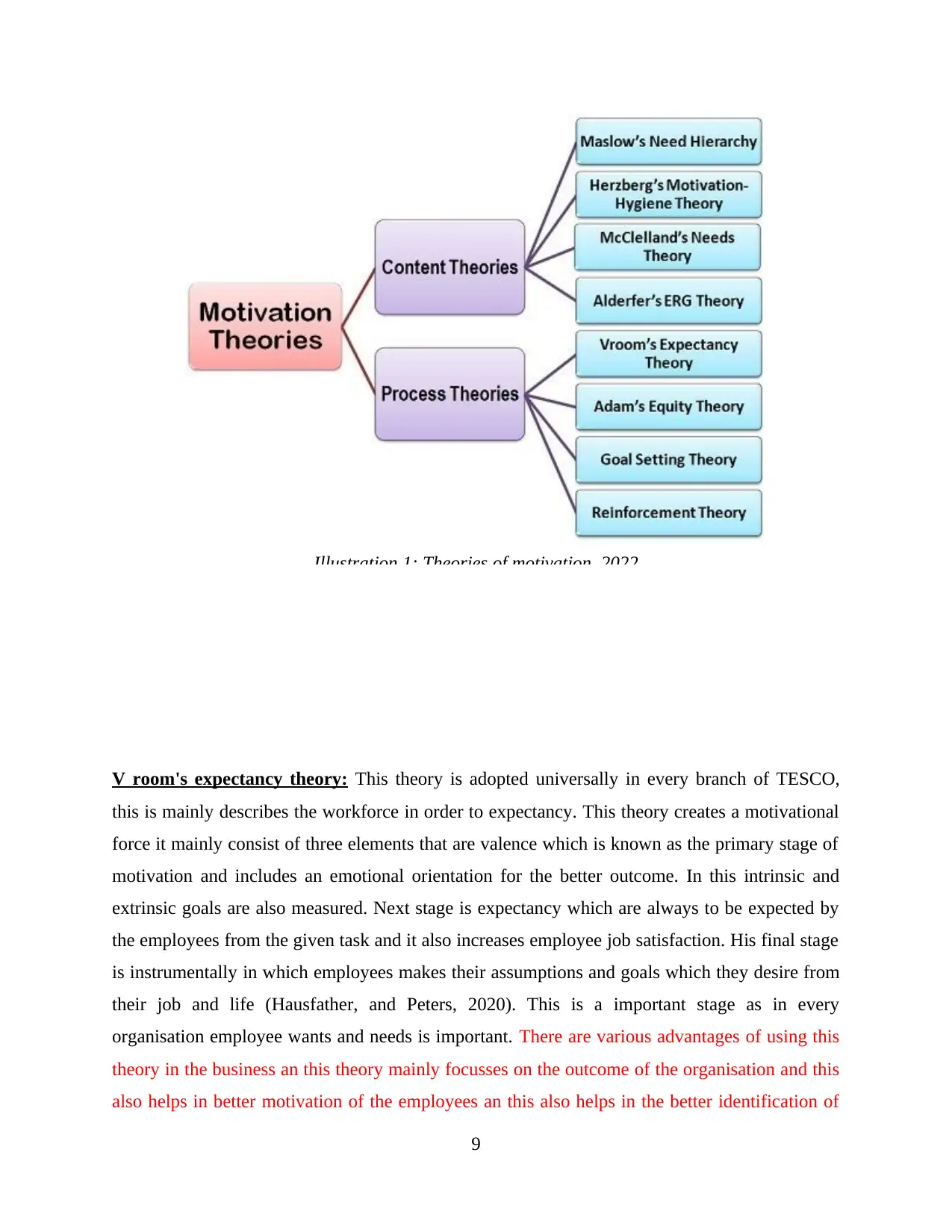
V room's expectancy theory: This theory is adopted universally in every branch of TESCO,
this is mainly describes the workforce in order to expectancy. This theory creates a motivational
force it mainly consist of three elements that are valence which is known as the primary stage of
motivation and includes an emotional orientation for the better outcome. In this intrinsic and
extrinsic goals are also measured. Next stage is expectancy which are always to be expected by
the employees from the given task and it also increases employee job satisfaction. His final stage
is instrumentally in which employees makes their assumptions and goals which they desire from
their job and life (Hausfather, and Peters, 2020). This is a important stage as in every
organisation employee wants and needs is important. There are various advantages of using this
theory in the business an this theory mainly focusses on the outcome of the organisation and this
also helps in better motivation of the employees an this also helps in the better identification of
9
Illustration 1: Theories of motivation, 2022
this is mainly describes the workforce in order to expectancy. This theory creates a motivational
force it mainly consist of three elements that are valence which is known as the primary stage of
motivation and includes an emotional orientation for the better outcome. In this intrinsic and
extrinsic goals are also measured. Next stage is expectancy which are always to be expected by
the employees from the given task and it also increases employee job satisfaction. His final stage
is instrumentally in which employees makes their assumptions and goals which they desire from
their job and life (Hausfather, and Peters, 2020). This is a important stage as in every
organisation employee wants and needs is important. There are various advantages of using this
theory in the business an this theory mainly focusses on the outcome of the organisation and this
also helps in better motivation of the employees an this also helps in the better identification of
9
Illustration 1: Theories of motivation, 2022
⊘ This is a preview!⊘
Do you want full access?
Subscribe today to unlock all pages.

Trusted by 1+ million students worldwide
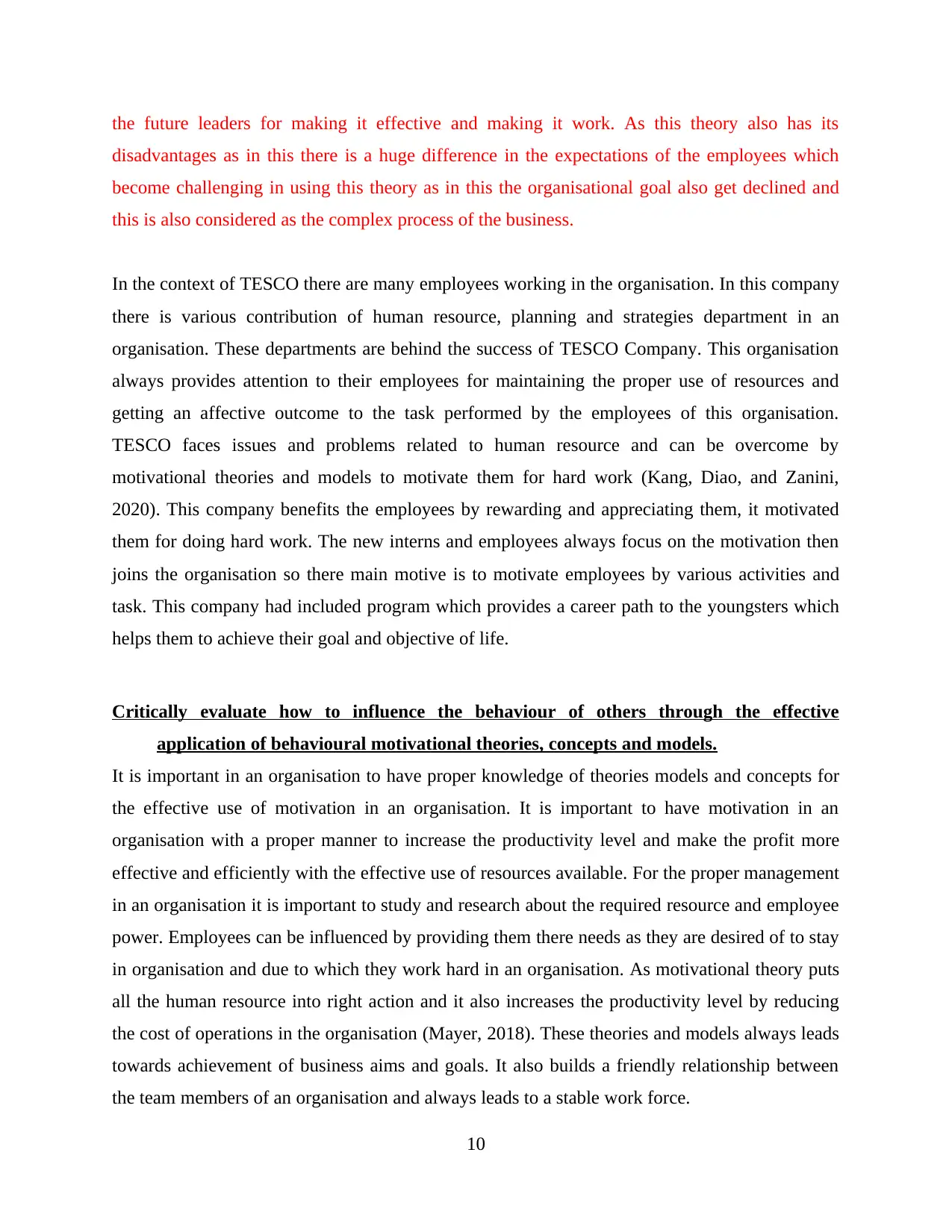
the future leaders for making it effective and making it work. As this theory also has its
disadvantages as in this there is a huge difference in the expectations of the employees which
become challenging in using this theory as in this the organisational goal also get declined and
this is also considered as the complex process of the business.
In the context of TESCO there are many employees working in the organisation. In this company
there is various contribution of human resource, planning and strategies department in an
organisation. These departments are behind the success of TESCO Company. This organisation
always provides attention to their employees for maintaining the proper use of resources and
getting an affective outcome to the task performed by the employees of this organisation.
TESCO faces issues and problems related to human resource and can be overcome by
motivational theories and models to motivate them for hard work (Kang, Diao, and Zanini,
2020). This company benefits the employees by rewarding and appreciating them, it motivated
them for doing hard work. The new interns and employees always focus on the motivation then
joins the organisation so there main motive is to motivate employees by various activities and
task. This company had included program which provides a career path to the youngsters which
helps them to achieve their goal and objective of life.
Critically evaluate how to influence the behaviour of others through the effective
application of behavioural motivational theories, concepts and models.
It is important in an organisation to have proper knowledge of theories models and concepts for
the effective use of motivation in an organisation. It is important to have motivation in an
organisation with a proper manner to increase the productivity level and make the profit more
effective and efficiently with the effective use of resources available. For the proper management
in an organisation it is important to study and research about the required resource and employee
power. Employees can be influenced by providing them there needs as they are desired of to stay
in organisation and due to which they work hard in an organisation. As motivational theory puts
all the human resource into right action and it also increases the productivity level by reducing
the cost of operations in the organisation (Mayer, 2018). These theories and models always leads
towards achievement of business aims and goals. It also builds a friendly relationship between
the team members of an organisation and always leads to a stable work force.
10
disadvantages as in this there is a huge difference in the expectations of the employees which
become challenging in using this theory as in this the organisational goal also get declined and
this is also considered as the complex process of the business.
In the context of TESCO there are many employees working in the organisation. In this company
there is various contribution of human resource, planning and strategies department in an
organisation. These departments are behind the success of TESCO Company. This organisation
always provides attention to their employees for maintaining the proper use of resources and
getting an affective outcome to the task performed by the employees of this organisation.
TESCO faces issues and problems related to human resource and can be overcome by
motivational theories and models to motivate them for hard work (Kang, Diao, and Zanini,
2020). This company benefits the employees by rewarding and appreciating them, it motivated
them for doing hard work. The new interns and employees always focus on the motivation then
joins the organisation so there main motive is to motivate employees by various activities and
task. This company had included program which provides a career path to the youngsters which
helps them to achieve their goal and objective of life.
Critically evaluate how to influence the behaviour of others through the effective
application of behavioural motivational theories, concepts and models.
It is important in an organisation to have proper knowledge of theories models and concepts for
the effective use of motivation in an organisation. It is important to have motivation in an
organisation with a proper manner to increase the productivity level and make the profit more
effective and efficiently with the effective use of resources available. For the proper management
in an organisation it is important to study and research about the required resource and employee
power. Employees can be influenced by providing them there needs as they are desired of to stay
in organisation and due to which they work hard in an organisation. As motivational theory puts
all the human resource into right action and it also increases the productivity level by reducing
the cost of operations in the organisation (Mayer, 2018). These theories and models always leads
towards achievement of business aims and goals. It also builds a friendly relationship between
the team members of an organisation and always leads to a stable work force.
10
Paraphrase This Document
Need a fresh take? Get an instant paraphrase of this document with our AI Paraphraser
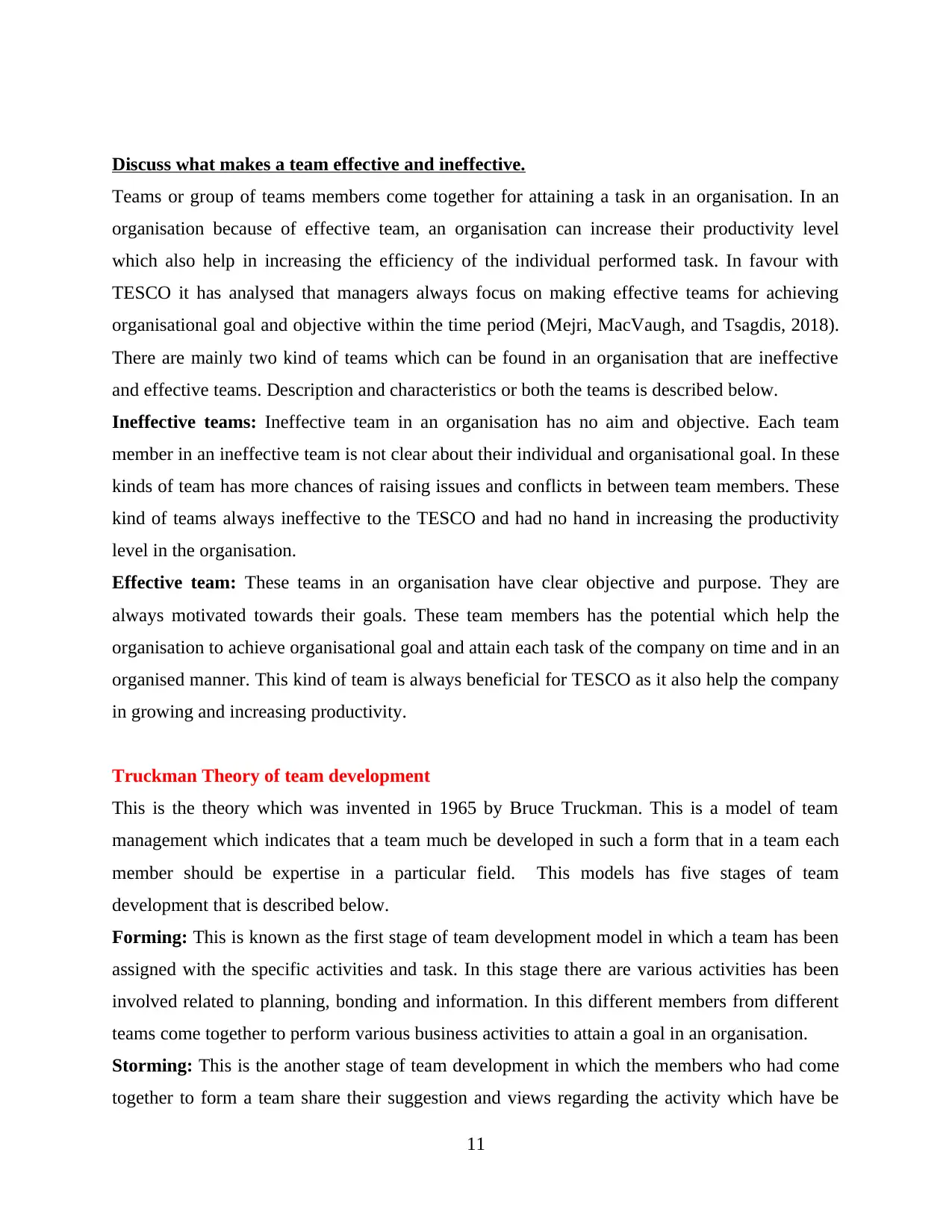
Discuss what makes a team effective and ineffective.
Teams or group of teams members come together for attaining a task in an organisation. In an
organisation because of effective team, an organisation can increase their productivity level
which also help in increasing the efficiency of the individual performed task. In favour with
TESCO it has analysed that managers always focus on making effective teams for achieving
organisational goal and objective within the time period (Mejri, MacVaugh, and Tsagdis, 2018).
There are mainly two kind of teams which can be found in an organisation that are ineffective
and effective teams. Description and characteristics or both the teams is described below.
Ineffective teams: Ineffective team in an organisation has no aim and objective. Each team
member in an ineffective team is not clear about their individual and organisational goal. In these
kinds of team has more chances of raising issues and conflicts in between team members. These
kind of teams always ineffective to the TESCO and had no hand in increasing the productivity
level in the organisation.
Effective team: These teams in an organisation have clear objective and purpose. They are
always motivated towards their goals. These team members has the potential which help the
organisation to achieve organisational goal and attain each task of the company on time and in an
organised manner. This kind of team is always beneficial for TESCO as it also help the company
in growing and increasing productivity.
Truckman Theory of team development
This is the theory which was invented in 1965 by Bruce Truckman. This is a model of team
management which indicates that a team much be developed in such a form that in a team each
member should be expertise in a particular field. This models has five stages of team
development that is described below.
Forming: This is known as the first stage of team development model in which a team has been
assigned with the specific activities and task. In this stage there are various activities has been
involved related to planning, bonding and information. In this different members from different
teams come together to perform various business activities to attain a goal in an organisation.
Storming: This is the another stage of team development in which the members who had come
together to form a team share their suggestion and views regarding the activity which have be
11
Teams or group of teams members come together for attaining a task in an organisation. In an
organisation because of effective team, an organisation can increase their productivity level
which also help in increasing the efficiency of the individual performed task. In favour with
TESCO it has analysed that managers always focus on making effective teams for achieving
organisational goal and objective within the time period (Mejri, MacVaugh, and Tsagdis, 2018).
There are mainly two kind of teams which can be found in an organisation that are ineffective
and effective teams. Description and characteristics or both the teams is described below.
Ineffective teams: Ineffective team in an organisation has no aim and objective. Each team
member in an ineffective team is not clear about their individual and organisational goal. In these
kinds of team has more chances of raising issues and conflicts in between team members. These
kind of teams always ineffective to the TESCO and had no hand in increasing the productivity
level in the organisation.
Effective team: These teams in an organisation have clear objective and purpose. They are
always motivated towards their goals. These team members has the potential which help the
organisation to achieve organisational goal and attain each task of the company on time and in an
organised manner. This kind of team is always beneficial for TESCO as it also help the company
in growing and increasing productivity.
Truckman Theory of team development
This is the theory which was invented in 1965 by Bruce Truckman. This is a model of team
management which indicates that a team much be developed in such a form that in a team each
member should be expertise in a particular field. This models has five stages of team
development that is described below.
Forming: This is known as the first stage of team development model in which a team has been
assigned with the specific activities and task. In this stage there are various activities has been
involved related to planning, bonding and information. In this different members from different
teams come together to perform various business activities to attain a goal in an organisation.
Storming: This is the another stage of team development in which the members who had come
together to form a team share their suggestion and views regarding the activity which have be
11
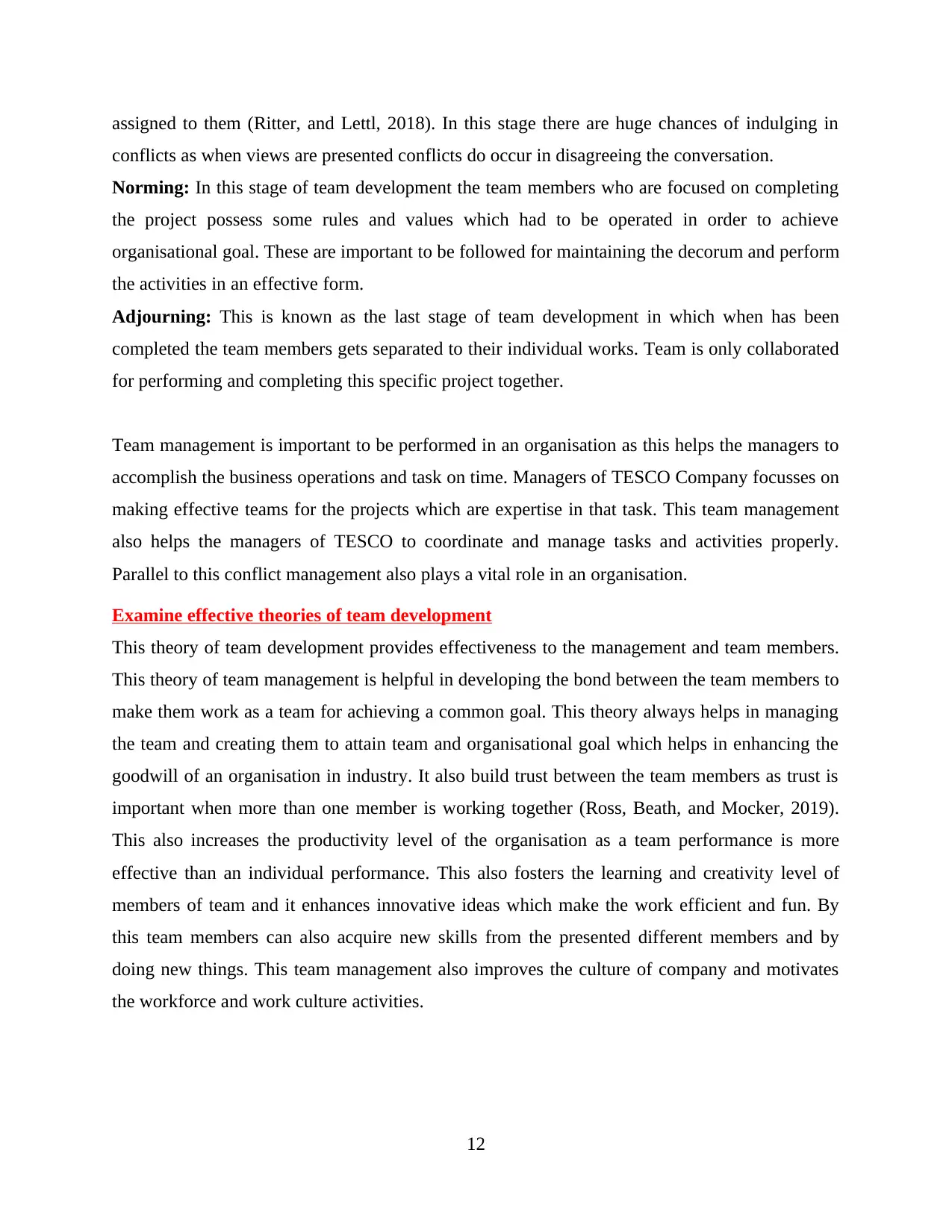
assigned to them (Ritter, and Lettl, 2018). In this stage there are huge chances of indulging in
conflicts as when views are presented conflicts do occur in disagreeing the conversation.
Norming: In this stage of team development the team members who are focused on completing
the project possess some rules and values which had to be operated in order to achieve
organisational goal. These are important to be followed for maintaining the decorum and perform
the activities in an effective form.
Adjourning: This is known as the last stage of team development in which when has been
completed the team members gets separated to their individual works. Team is only collaborated
for performing and completing this specific project together.
Team management is important to be performed in an organisation as this helps the managers to
accomplish the business operations and task on time. Managers of TESCO Company focusses on
making effective teams for the projects which are expertise in that task. This team management
also helps the managers of TESCO to coordinate and manage tasks and activities properly.
Parallel to this conflict management also plays a vital role in an organisation.
Examine effective theories of team development
This theory of team development provides effectiveness to the management and team members.
This theory of team management is helpful in developing the bond between the team members to
make them work as a team for achieving a common goal. This theory always helps in managing
the team and creating them to attain team and organisational goal which helps in enhancing the
goodwill of an organisation in industry. It also build trust between the team members as trust is
important when more than one member is working together (Ross, Beath, and Mocker, 2019).
This also increases the productivity level of the organisation as a team performance is more
effective than an individual performance. This also fosters the learning and creativity level of
members of team and it enhances innovative ideas which make the work efficient and fun. By
this team members can also acquire new skills from the presented different members and by
doing new things. This team management also improves the culture of company and motivates
the workforce and work culture activities.
12
conflicts as when views are presented conflicts do occur in disagreeing the conversation.
Norming: In this stage of team development the team members who are focused on completing
the project possess some rules and values which had to be operated in order to achieve
organisational goal. These are important to be followed for maintaining the decorum and perform
the activities in an effective form.
Adjourning: This is known as the last stage of team development in which when has been
completed the team members gets separated to their individual works. Team is only collaborated
for performing and completing this specific project together.
Team management is important to be performed in an organisation as this helps the managers to
accomplish the business operations and task on time. Managers of TESCO Company focusses on
making effective teams for the projects which are expertise in that task. This team management
also helps the managers of TESCO to coordinate and manage tasks and activities properly.
Parallel to this conflict management also plays a vital role in an organisation.
Examine effective theories of team development
This theory of team development provides effectiveness to the management and team members.
This theory of team management is helpful in developing the bond between the team members to
make them work as a team for achieving a common goal. This theory always helps in managing
the team and creating them to attain team and organisational goal which helps in enhancing the
goodwill of an organisation in industry. It also build trust between the team members as trust is
important when more than one member is working together (Ross, Beath, and Mocker, 2019).
This also increases the productivity level of the organisation as a team performance is more
effective than an individual performance. This also fosters the learning and creativity level of
members of team and it enhances innovative ideas which make the work efficient and fun. By
this team members can also acquire new skills from the presented different members and by
doing new things. This team management also improves the culture of company and motivates
the workforce and work culture activities.
12
⊘ This is a preview!⊘
Do you want full access?
Subscribe today to unlock all pages.

Trusted by 1+ million students worldwide
1 out of 17
Related Documents
Your All-in-One AI-Powered Toolkit for Academic Success.
+13062052269
info@desklib.com
Available 24*7 on WhatsApp / Email
![[object Object]](/_next/static/media/star-bottom.7253800d.svg)
Unlock your academic potential
Copyright © 2020–2025 A2Z Services. All Rights Reserved. Developed and managed by ZUCOL.





